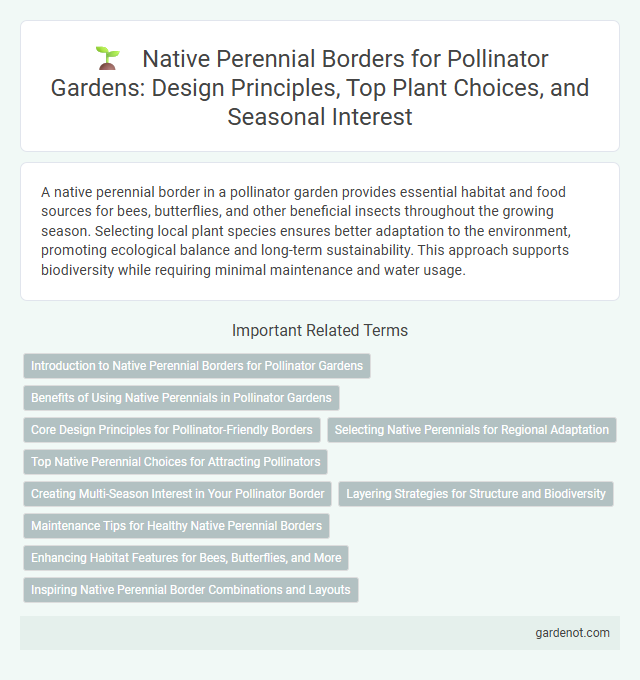A native perennial border in a pollinator garden provides essential habitat and food sources for bees, butterflies, and other beneficial insects throughout the growing season. Selecting local plant species ensures better adaptation to the environment, promoting ecological balance and long-term sustainability. This approach supports biodiversity while requiring minimal maintenance and water usage.
Introduction to Native Perennial Borders for Pollinator Gardens
Native perennial borders feature diverse, region-specific flowering plants that bloom throughout the growing season, providing essential nectar and pollen sources for bees, butterflies, and other pollinators. These borders enhance ecological balance by supporting local pollinator populations and improving habitat connectivity within urban and suburban landscapes. Incorporating native perennials such as Echinacea, Aster, and Monarda increases garden resilience and sustainability while promoting biodiversity.
Benefits of Using Native Perennials in Pollinator Gardens
Native perennial borders in pollinator gardens provide essential habitats and food sources, promoting biodiversity by supporting native pollinator species like bees, butterflies, and hummingbirds. These plants are adapted to local soil and climate conditions, resulting in reduced maintenance and higher resilience against pests and diseases. Utilizing native perennials enhances pollination efficiency, contributing to healthier ecosystems and improved growth of surrounding plants and crops.
Core Design Principles for Pollinator-Friendly Borders
Native perennial borders designed for pollinator gardens prioritize plant diversity to support a wide range of pollinators like bees, butterflies, and hummingbirds throughout multiple seasons. Incorporating layers of varying flower heights and bloom times ensures continuous nectar and pollen availability, enhancing habitat quality and pollinator health. Selecting region-specific native species increases ecological resilience while reducing maintenance needs through natural adaptation to local soils and climate.
Selecting Native Perennials for Regional Adaptation
Selecting native perennials for a pollinator garden enhances regional adaptation by supporting local pollinators with plants evolved in the same ecosystem. Species like Echinacea purpurea, Asclepias tuberosa, and Rudbeckia hirta provide essential nectar and pollen throughout the growing season while thriving in local soil and climate conditions. Choosing region-specific native perennials reduces maintenance needs and increases garden resilience, promoting a sustainable habitat for bees, butterflies, and other beneficial insects.
Top Native Perennial Choices for Attracting Pollinators
Top native perennial choices for attracting pollinators include Echinacea purpurea (purple coneflower), Asclepias tuberosa (butterfly weed), and Monarda fistulosa (wild bergamot). These perennials provide abundant nectar and pollen resources, supporting diverse pollinator species such as bees, butterflies, and hummingbirds. Planting a diverse border of native perennials enhances ecosystem stability and promotes year-round pollinator activity.
Creating Multi-Season Interest in Your Pollinator Border
Incorporate native perennials such as Echinacea, Monarda, and Rudbeckia to provide vibrant blooms throughout spring, summer, and fall, attracting a diverse range of pollinators. Staggered flowering times ensure continuous nectar and pollen sources for bees, butterflies, and hummingbirds, enhancing biodiversity. Layering plants of varying heights and bloom colors creates dynamic visual interest and supports ecosystem health year-round.
Layering Strategies for Structure and Biodiversity
Native perennial borders enhance pollinator gardens by using layering strategies that create dynamic vertical and horizontal habitats supporting diverse insect species. Incorporating tall, medium, and low-growing native perennials like Purple Coneflower (Echinacea purpurea), Black-eyed Susan (Rudbeckia hirta), and Wild Bergamot (Monarda fistulosa) fosters continuous bloom cycles and varied microclimates. These layered plantings optimize nectar sources, shelter, and breeding grounds, significantly boosting biodiversity and ecological resilience.
Maintenance Tips for Healthy Native Perennial Borders
Maintaining healthy native perennial borders in a pollinator garden requires regular weeding to reduce competition for nutrients and water, along with seasonal mulching to retain soil moisture and suppress invasive species. Pruning dead or diseased stems in early spring encourages vigorous growth and enhances flowering, benefiting pollinators like bees and butterflies. Monitoring for pests and diseases and using organic pest control methods ensures the long-term health and biodiversity of native plants such as milkweed, coneflowers, and black-eyed Susans.
Enhancing Habitat Features for Bees, Butterflies, and More
Native perennial borders provide essential nectar sources and shelter that support diverse pollinators such as bees, butterflies, and hummingbirds. Incorporating a variety of flowering native plants with staggered bloom times maximizes food availability throughout the growing season. Structural features like dense foliage and bare ground patches enhance nesting and overwintering habitats, boosting pollinator populations and biodiversity.
Inspiring Native Perennial Border Combinations and Layouts
Native perennial border combinations featuring coneflowers, black-eyed Susans, and bee balm create vibrant habitats that attract diverse pollinators such as bees, butterflies, and hummingbirds. Strategic layering of varying bloom times and plant heights ensures continuous nectar sources and visual interest throughout the growing season. Incorporating species like goldenrod and milkweed enhances ecological value while supporting native pollinator populations in a sustainable garden layout.
Native perennial border Infographic

 gardenot.com
gardenot.com